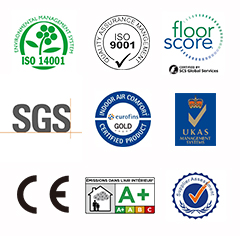Five things you need to know about WPC
The “w” stands for wood, but the fact is the majority of WPC-type products entering the market today do not contain wood. WPC is a composite material made of thermoplastics, calcium carbonate and wood flour. Extruded as a core material, it is marketed as being waterproof, rigid and dimensionally stable. In an effort to differentiate their products, suppliers are branding their WPC offerings with names such as enhanced vinyl plank, engineered luxury vinyl flooring and waterproof vinyl.
Shaw Floors, for example, brands its Floorté as enhanced vinyl plank with an “improved formulation” that gives it greater density than WPC. Mannington’s new Adura Max is an enhanced vinyl plank the company is touting as the “quietest product on the market.”
The main differences are that WPC is waterproof and can go over most subfloors without much preparation. Traditional vinyl floors are flexible and any unevenness in the subfloor will transfer through the surface. Compared to traditional glue-down LVT or solid-locking LVT, WPC products have a distinct advantage because the rigid core hides subfloor imperfections. In addition, the rigid core allows for longer and wider formats. With WPC, it is not necessary to worry about the preparation LVT would require for use over cracks and divots in concrete or wooden subfloors.
The big advantage for WPC over laminate is that it is waterproof and suitable for environments in which laminate shouldn’t normally be used—typically bathrooms and basements that have potential moisture infiltration. In addition, WPC products can be installed in large rooms without an expansion gap every 30 feet, which is a requirement for laminate floors. The vinyl wear layer of WPC provides cushion and comfort and also absorbs the impact sound to make it a quiet floor. WPC is also suitable for large open areas (basements and Main Street commercial areas) because it doesn’t need expansion moldings.
Most manufacturers regard WPC as a subcategory of LVT. As such, it is likely to be displayed among other resilient and/or LVT products. Some retailers have WPC displayed between laminate and LVT or vinyl since it is the ultimate “crossover” category.
Jim Mudd, president of Sam Kinnaird’s Flooring in Louisville, Ky., merchandises WPC in the laminate section. “I consider WPC laminate even though I don’t think it matters,” he said. “All I care about is that the product is waterproof and quiet [underfoot].”
Is WPC a fad or the next big thing in flooring? No one can know for sure, but indications are this product offers great potential. “It absolutely can become the dominant player,” said Eric Mondragon, hard surface buyer for R.C. Willey Home Furnishings, with 13 locations in four Western states. “WPC is what the LVT category has evolved to, although I still see the need for traditional dry-back LVT for multi-family and commercial segments of the market.”
USFloors helped usher in the WPC era with the launch of COREtec three Surfaces ago. In 2015, the company received a patent that covers all engineered flooring products with a WPC core and veneer top layer with or without an attached backing. Noting that WPC is still at the early stages of its lifecycle and expansion, Piet Dossche, CEO of USFloors, predicted WPC “will forever change the landscape of LVT and several other flooring categories.” Specfically, he suggested some categories may even need to be reinvented.
That change could be happening soon. Jeff Striegel, president of Elias Wilf, a Top 20 distributor based in Owings Mills, Md., expects WPC to be the talk of Surfaces with as many as 40 introductions. “Any time you have a product that solves a problem it seems to do well,” he said. “One of the issues people have with LVT is that there is some telegraphing and, therefore, are limitations with what you can put LVT over. That is not the case with WPC. It is clearly a trend that is on the move.”









